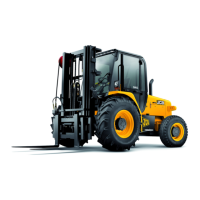Operation
Operating Levers
44 44
9811/5700-7
Operating Levers
Introduction
!MWARNING
Controls
You or others can be killed or seriously injured if you
operate the control levers from outside the machine.
Operate the control levers only when you are correctly
seated.
0179_2
!MWARNING
Mast/Travelling
Operating the mast and carriage while travelling can
cause accidents. You will not have total control. Never
operate the mast and carriage while travelling.
9-1-3-2
!MWARNING
Electrical Power Cables
You could be electrocuted or badly burned if you get
the machine or its attachments too close to electrical
power cables.
You are strongly advised to make sure that the safety
arrangements on site comply with the local laws and
regulations concerning work near electric power lines.
Before you start using the machine, check with your
electricity supplier if there are any buried power
cables on the site.
There is a minimum clearance required for working
beneath overhead power cables. You must obtain
details from your local electricity supplier.
2-2-5-4
!MWARNING
Make sure that it is clear overhead before raising the
mast.
9-2-1-2
The mast and its carriage are operated by levers 1 and 2.
Your machine may have up to two additional levers 3 and
4. These operate optional services when fitted.
K
Auxiliary Controls ( T 46).
!MWARNING
Control lever/switch action may vary on machines,
instructional labels near the levers/switches show by
symbols, which levers/switches cause what actions.
Before operating control levers/switches check the
instructional label to make sure you select the desired
action.
5-2-2-9_2
All levers move forward and back. The levers are spring-
loaded to their central hold positions. The speed of
movement of the associated hydraulic rams depends on
how far you move a lever - the further you move the lever,
the faster the ram action.
The rams will stay in any position until you move them with
the levers. (The mast descends by gravity, at a speed
which is controlled by a flow regulator in the hydraulic
circuit).
The following pages describe the operation of the various
control patterns.
Fig 33.

